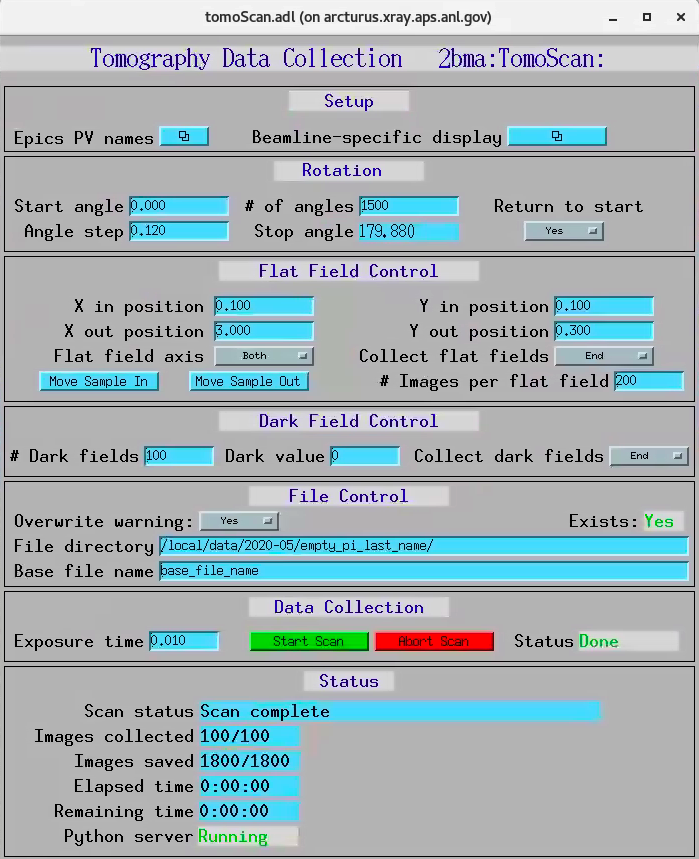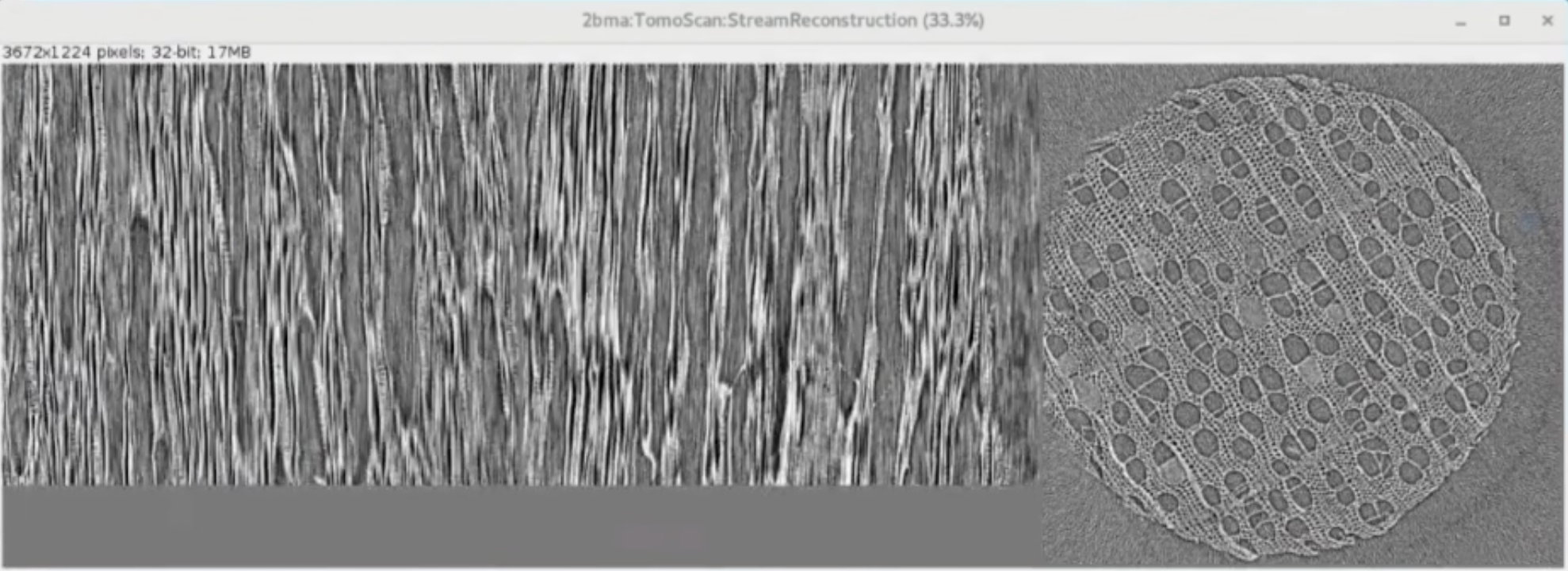Data Collection¶
TomoScan¶
The tomography scans are managed by tomoScan. Please refer to the tomoScan documentation for details.
To configure a single tomographic scan enter the acquistion parameters at:

To run a single scan with the parameters set in the tomoScan screen press the gree Start Scan button. To collect the same from the command line interface:
[user2bmb@pg10ge]$ tomoscan single
tomoscan supports also vertical, horizontal and mosaic tomographic scans with:
[user2bmb@pg10ge]$ tomoscan vertical
[user2bmb@pg10ge]$ tomoscan horizontal
[user2bmb@pg10ge]$ tomoscan mosaic
to run a vertical scan:
$ [user2bmb@pg10ge]$ tomoscan vertical --vertical-start 0 --vertical-step-size 0.1 --vertical-steps 2
2020-05-29 16:54:03,354 - vertical scan start
2020-05-29 16:54:03,356 - vertical positions (mm): [0. 0.1]
2020-05-29 16:54:03,358 - SampleInY stage start position: 0.000 mm
2020-05-29 16:54:03,362 - single scan start
2020-05-29 16:54:51,653 - single scan time: 0.805 minutes
2020-05-29 16:54:51,654 - SampleInY stage start position: 0.100 mm
2020-05-29 16:54:51,658 - single scan start
2020-05-29 16:55:47,607 - single scan time: 0.932 minutes
2020-05-29 16:55:47,607 - vertical scan time: 1.738 minutes
2020-05-29 16:55:47,608 - vertical scan end
to run a series of vertical scans starting from different locations:
[user2bmb@pg10ge]$ for k in {0,5.2,10.4,15.6,20.8,26}; do tomoscan vertical --vertical-start $k --vertical-step-size 1.3 --vertical-steps 4; done
this will run:
[user2bmb@pg10ge]$ tomoscan vertical --vertical-start 0 --vertical-step-size 1.3 --vertical-steps 4
[user2bmb@pg10ge]$ tomoscan vertical --vertical-start 5.2 --vertical-step-size 1.3 --vertical-steps 4
[user2bmb@pg10ge]$ tomoscan vertical --vertical-start 10.4 --vertical-step-size 1.3 --vertical-steps 4
[user2bmb@pg10ge]$ tomoscan vertical --vertical-start 15.6 --vertical-step-size 1.3 --vertical-steps 4
[user2bmb@pg10ge]$ tomoscan vertical --vertical-start 20.8 --vertical-step-size 1.3 --vertical-steps 4
[user2bmb@pg10ge]$ tomoscan vertical --vertical-start 26 --vertical-step-size 1.3 --vertical-steps 4
please check the command line manual for more details.
Streaming data collection¶
tomoScan provides also support for streaming data collection (see tomoScanStream documentation for details). When collecting data in streaming mode, projections, dark and flat images are broadcasted using PVaccess and can be retrieved as EPICS PVs.
Streaming data collection features are:
Projection, dark and flat image broadcast as PV access variables
On-demand retake of dark-flat field images
On-demand data capturing with saving in a standard Data Exchange hdf5file
Set a number of projectons (“Pre count”) collected before a triggered data capturing event to be also saved in the same hdf5 file
All TomoScanStream functionalies can be controlled from the Streaming Control section of:

Streaming data reconstruction¶
The projection, dark and flat image broadcast provided by tomoScanStream can be used to reconstruct in real-time 3 orthogonal slices. This task is accomplished by tomoStream.
Streaming data reconstruction features are:
Streaming reconstruction of 3 (X-Y-Z) ortho-slices through the sample
On demand adjustment of the
X Y Z ortho-slice positions
reconstruction rotation center
reconstruction filter
All tomoStream functionalies can be controlled from the tomoStream user interface:

The output of tomostream is a live reconstruction diplaying in ImageJ using the EPICS_NTNDA_Viewer plug-in:

While the sample is rotating is possible to optimize instrument (alignment, focus, sample to detector distance etc.) and beamline (energy etc.) conditions and monitor the effect live on the 3 orthogonal slices. It is also possible to automatically trigger data capturing based on events occurring in the sample and its environment as a result of segmentation or machine learning.
Bluesky¶
To operate 2-BM using bluesky (currently in beta test in 2-BM-B) type:
user2bmb@lyra$ use_bluesky.sh 2bmb
Once in the ipython shell type:
RE(user_tomo_scan(), comment="my tomo fly scan", sample="wood stick")
or:
RE(user_tomo_scan(acquire_time=0.1), comment="my tomo fly scan", sample="wood stick")
RE(user_tomo_scan(acquire_time=0.1, iteration=10), comment="my tomo fly scan", sample="wood stick")